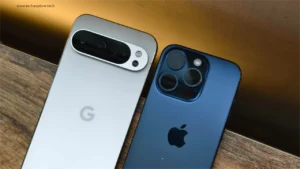With the release of the iPhone 16 and the Google Pixel 9 Pro XL, 2024 has brought two powerhouses to the smartphone market. Both Apple and Google have long been at the forefront of mobile innovation, and their latest flagships once again showcase their respective strengths. In this comparison, we’ll explore key aspects like design, display, performance, camera, and software to determine which phone stands out in the battle of these tech giants.

| Feature | iPhone 16 Pro | Google Pixel 9 Pro XL |
|---|---|---|
| Operating System | iOS 18 | Android 15 |
| Display | 6.1-inch Super Retina XDR OLED, 120Hz | 6.7-inch LTPO OLED, 120Hz, QHD+ |
| Processor | Apple A18 Bionic chip | Google Tensor G5 |
| RAM | 8GB | 12GB |
| Storage Options | 128GB, 256GB, 512GB, 1TB | 128GB, 256GB, 512GB |
| Main Cameras | Triple 48MP (Main, Ultra-wide, Telephoto) | Triple 50MP (Main, Ultra-wide, Telephoto) |
| Front Camera | 12MP | 12MP |
| Battery | 4,000mAh (est.) with fast charging | 5,100mAh with fast charging |
| Charging Speed | 30W wired, 15W MagSafe wireless charging | 30W wired, 23W wireless charging |
| Build Material | Stainless steel, Ceramic Shield front | Aluminum frame, Gorilla Glass Victus front |
| Water Resistance | IP68 | IP68 |
| Biometrics | Face ID | In-display fingerprint sensor, Face Unlock |
| Connectivity | 5G, Wi-Fi 6E, Bluetooth 5.3 | 5G, Wi-Fi 6E, Bluetooth 5.3 |
| Software Features | Dynamic Island, ProRAW, ProRes video | Google AI features, Magic Eraser, Photo Unblur |
| Colors | Graphite, Gold, Silver, Deep Purple | Obsidian, Snow, Hazel |
| Starting Price | $1,099 | $999 |
1. Design and Build Quality
Apple and Google have their own distinct design philosophies. The iPhone 16 retains Apple’s premium build with surgical-grade stainless steel frames, a ceramic shield front, and a matte-textured glass back. The overall design is sleek, refined, and maintains the signature flat edges seen in recent iPhones.
The Google Pixel 9 Pro XL, on the other hand, sticks with Google’s more playful, curved design with a combination of glass and aluminum. The camera bar remains a hallmark of the Pixel series, making the phone instantly recognizable. In terms of aesthetics, Google has focused on making the Pixel 9 Pro XL more ergonomic, with subtle curves that fit comfortably in hand. While both phones boast premium materials, the iPhone 16 edges ahead in terms of durability, thanks to its stronger ceramic shield.
2. Display
The iPhone 16 features a 6.5-inch Super Retina XDR display with ProMotion technology, offering up to 120Hz refresh rates and incredibly vibrant colors. Apple’s OLED technology continues to lead in terms of color accuracy, brightness, and sharpness. The phone is capable of reaching 2000 nits in peak brightness, making it ideal for outdoor viewing.
The Pixel 9 Pro XL, meanwhile, comes with a slightly larger 6.7-inch AMOLED display with a 120Hz adaptive refresh rate. Google has significantly improved the brightness levels on the Pixel 9 series, making it comparable to the iPhone in outdoor conditions. However, where Google excels is in its software-driven display calibration. The Pixel 9 Pro XL’s screen provides accurate color reproduction and a natural feel that makes it ideal for photography enthusiasts.
Both displays are top-tier, but Apple’s mastery over display technology with features like ProMotion and True Tone gives the iPhone 16 a slight edge in fluidity and versatility.
3. Performance
Under the hood, the iPhone 16 is powered by Apple’s A18 Bionic chip, which delivers exceptional performance in both day-to-day tasks and heavy computing. The A18 chip, built on a 3nm process, offers better energy efficiency and faster neural engine performance, making it the go-to for users interested in gaming, AR applications, or heavy multitasking.
Google’s Pixel 9 Pro XL is powered by the Tensor G4 chipset, which is custom-built by Google. The Tensor G4 focuses on machine learning and AI-driven tasks, offering unique features like real-time language translation, voice processing, and computational photography enhancements. While the Tensor G4 might not match the raw benchmark numbers of the A18, it excels in areas like AI processing and efficiency, making it a highly capable and smart chip.
Overall, if you’re looking for raw performance, the iPhone 16 is the better choice. However, if you appreciate AI-powered features and smarter phone experiences, the Pixel 9 Pro XL brings a lot to the table.
4. Camera System
Both Apple and Google have cemented their reputation as leaders in smartphone photography, and the iPhone 16 and Pixel 9 Pro XL are no exception.
The iPhone 16 features a triple-camera system, including a 48MP main sensor, a 12MP ultrawide lens, and a 12MP telephoto lens with up to 6x optical zoom. Apple’s computational photography, including improvements in Night Mode and Deep Fusion, offers highly detailed and vibrant photos across various lighting conditions. The Smart HDR 6 technology ensures that every shot is well-balanced in terms of exposure and contrast.
The Google Pixel 9 Pro XL’s camera system, however, is one of the most advanced ever seen on a smartphone. It has a 50MP main sensor, a 48MP ultrawide, and a 12MP telephoto with 5x optical zoom. Where the Pixel excels is in its computational photography and software processing. Google’s AI-driven photo features, such as Magic Eraser, Photo Unblur, and Real Tone, deliver excellent results, especially in low-light conditions. Night Sight remains unmatched, and the natural color tuning of the Pixel 9 Pro XL creates incredibly lifelike images.
Both cameras are incredible, but if you’re a photography enthusiast, the Pixel 9 Pro XL’s computational photography and AI features give it a slight advantage, especially in low-light performance.
5. Software and Ecosystem
The iPhone 16 runs on iOS 18, Apple’s latest operating system, which is deeply integrated into its hardware and ecosystem. The seamless integration between iPhone, iPad, Mac, and Apple Watch is hard to beat. iOS 18 also brings features like enhanced widgets, new health-focused apps, and better privacy controls. Apple’s ecosystem continues to excel at offering a smooth, unified user experience.
The Google Pixel 9 Pro XL runs on Android 14, with the clean and user-friendly Google Pixel UI. The software experience is smooth, and Google’s AI and machine learning enhancements, especially around voice commands, predictive typing, and on-device translations, are cutting-edge. Google’s ecosystem is also expanding, with deep integration across Chromebooks, Nest devices, and WearOS watches.
In terms of software, it comes down to personal preference. Apple’s iOS offers better integration across a wider range of devices, but Google’s software is smarter and more personalized, thanks to its AI.
6. Battery Life and Charging
Apple’s iPhone 16 has improved battery performance, thanks to the A18 chip’s efficiency. The phone offers all-day battery life with moderate use and supports fast charging (up to 30W), along with MagSafe wireless charging.
The Google Pixel 9 Pro XL also impresses with its battery life. The Tensor G4’s efficiency ensures that it lasts through a full day of usage, and the phone supports 30W wired charging and up to 25W wireless charging. While Google doesn’t have an equivalent to MagSafe, the Pixel 9 Pro XL does support reverse wireless charging, which is useful for charging accessories like Pixel Buds.
Both phones offer strong battery life, with marginal differences in charging speed and wireless options.
Conclusion: Which is the Better Flagship?
Both the iPhone 16 and the Google Pixel 9 Pro XL are incredibly well-built smartphones with top-tier features. If you prioritize ecosystem integration, performance, and long-term software support, the iPhone 16 is an excellent choice. Its polished design, powerful A18 chip, and superior app ecosystem make it a fantastic all-around device.
On the other hand, if you’re someone who values photography, AI-powered features, and a more personalized software experience, the Google Pixel 9 Pro XL is the standout. Google’s advancements in AI, machine learning, and computational photography make it the perfect phone for tech enthusiasts.
Ultimately, the choice between the iPhone 16 and Google Pixel 9 Pro XL comes down to your priorities—whether it’s Apple’s cohesive ecosystem or Google’s smart, AI-driven features. Either way, you’re getting a top-tier phone that pushes the boundaries of mobile technology.
